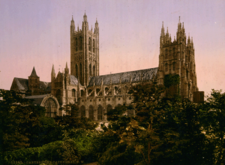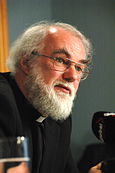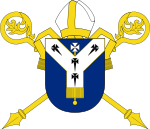Archbishop of Canterbury
2008/9 Schools Wikipedia Selection. Related subjects: Religious figures and leaders
The Archbishop of Canterbury is the chief bishop and principal leader of the Church of England, the symbolic head of the worldwide Anglican Communion and the diocesan bishop of the Diocese of Canterbury, the see that churches must be in communion with in order to be a part of the Anglican Communion.
The current archbishop is Rowan Williams who is the 104th in a line that goes back more than 1400 years to St Augustine of Canterbury, who founded the oldest see in England in the year 597.
From the time of St Augustine until the 16th century, the Archbishops of Canterbury were in full communion with the Roman Catholic Church. During the English Reformation the church broke away from the authority of the Pope and the Roman Catholic Church, at first temporarily and later more permanently. Since then they have been outside of the succession of the Roman Catholic Church's hierarchy and have led the independent national church.
In the Middle Ages there was considerable variation in the nomination of the Archbishop and other bishops — at various times the choice was made by the canons of Canterbury Cathedral, the King of England, or the Pope. Since the reformation, the church is explicitly a state church and the choice is legally that of the British crown; today it is made in the name of the Sovereign by the Prime Minister, from a shortlist of two selected by an ad hoc committee called the Crown Nominations Commission.
Present roles and status
Today the archbishop fills four main roles:
- He is the diocesan bishop of the Diocese of Canterbury, which covers the east of the County of Kent. Founded in 597, it is the oldest see in the English church.
- He is the metropolitan archbishop of the Province of Canterbury, which covers the southern two-thirds of England.
- As Primate of All England, he is the chief religious figure in the Church of England (the British sovereign is the " Supreme governor" of the church) and its primary leader. Along with his colleague the Archbishop of York he chairs the General Synod and sits or chairs many of the church's important boards and committees; power in the church is not highly centralised, however, so the two archbishops can often lead only through persuasion. The Archbishop of Canterbury plays a central part in national ceremonies such as coronations; thanks to his high public profile, his opinions are often in demand by the news media.
- As spiritual leader of the Anglican Communion, the archbishop, although without legal authority outside England, is recognised by convention as primus inter pares ("first among equals") of all Anglican primates worldwide. Since 1867 he has convened more or less decennial meetings of worldwide Anglican bishops, the Lambeth Conferences.
In respect of the last two of these functions, he has an important ecumenical and interfaith role, speaking on behalf of Anglicans in England and worldwide.
The Archbishop's main residence is Lambeth Palace in the London Borough of Lambeth. He also has lodgings in the Old Palace, Canterbury, located beside Canterbury Cathedral, where The Chair of St. Augustine sits.
As holder of one of the "five great sees" (the others being York, London, Durham and Winchester), the Archbishop of Canterbury is ex officio one of the Lords Spiritual of the House of Lords. He is one of the highest-ranking men in England and the highest ranking non-royal in the United Kingdom's order of precedence.
Since Henry VIII broke with Rome, the Archbishops of Canterbury have been selected by the English (British since the Act of Union in 1707) monarch. Today the choice is made in the name of the Sovereign by the prime minister, from a shortlist of two selected by an ad-hoc committee called the Crown Nominations Commission. Since the twentieth century, the appointment of Archbishops of Canterbury conventionally alternates between Anglo-Catholics and Evangelicals.
The current archbishop, the Most Reverend and Right Honourable Rowan Douglas Williams, is the 104th Archbishop of Canterbury. He was enthroned at Canterbury Cathedral on 27 February 2003. As archbishop he signs himself as + Rowan Cantuar. Immediately prior to his appointment to Canterbury he was the Bishop of Monmouth in Wales. Whilst at Monmouth he was later, for a shorter period, also the Archbishop of Wales.
Additional roles
In addition to his office, the Archbishop also holds a number of other positions; for example, he is Joint President of the Council of Christians and Jews in the UK. Some positions he formally holds ex officio and others virtually so (the incumbent of the day, although appointed personally, is appointed because of his office). Amongst these are:
|
|
Origins
It has been suggested that the Roman province of Britannia had four archbishops, seated at London, York, Lincoln, and Cirencester. However, in the 5th and 6th centuries Britannia began to be overrun by pagan, Germanic peoples who came to be known collectively as the Anglo-Saxons. Of the kingdoms they created, Kent arguably had the closest links with European politics, trade and culture, due to the fact that it was conveniently sited for communication with the Continent. In the late 6th century, King Æthelberht of Kent married a Christian Frankish princess named Bertha, possibly before becoming king, and certainly a number of years before the arrival of the first Christian mission to England. He permitted the preaching of Christianity.
The first Archbishop of Canterbury was St. Augustine, who arrived in Kent in 597 AD, having been sent by Pope Gregory the Great on a mission to the English. He was accepted by King Æthelbert, on his conversion to Christianity, in about the year 598. It seems that Pope Gregory, ignorant of recent developments in the former Roman province, including the spread of the Pelagian heresy, had intended the new archiepiscopal sees for England to be established in London and York. In the event, Canterbury was chosen instead of London, owing to political circumstances. Since then the Archbishops of Canterbury have been referred to as occupying the Chair of St. Augustine.
Before the break with Papal authority in the 16th century, the Church of England was an integral part of the continental Western European Church. Since the break the Church of England, an established national church, still considers itself part of the broader Western Catholic tradition as well as being the "mother church" of the worldwide Anglican Communion, though no longer in communion with the See of Rome.
Province and Diocese
The Archbishop of Canterbury exercises metropolitical (or supervisory) jurisdiction over the Province of Canterbury, which encompasses thirty of the forty-four dioceses of the Church of England, with the rest falling within the Province of York. The four dioceses of Wales were formerly also under the Province of Canterbury but in 1920 they were transferred from the established Church of England to the disestablished Church in Wales.

The Archbishop of Canterbury has a ceremonial provincial curia, or court, consisting of some of the senior bishops of his province. The Bishop of London—the most senior cleric of the Church with the exception of the two Archbishops—serves as Canterbury's Provincial Dean, the Bishop of Winchester as Chancellor, the Bishop of Lincoln as Vice-Chancellor, the Bishop of Salisbury as Precentor, the Bishop of Worcester as Chaplain and the Bishop of Rochester as Cross-Bearer.
Along with primacy over the Archbishop of York, the Archbishop of Canterbury also has a precedence of honour over the other archbishops of the Anglican Communion. He is recognised as primus inter pares, or first amongst equals. The Archbishop of Canterbury, however, does not exercise any direct authority in the provinces outside England.
The Archbishop at the present time has four suffragan bishops:
- The Bishop of Dover is given the additional title of "Bishop in Canterbury" and empowered to act almost as if he were the diocesan bishop of the Diocese of Canterbury, since the Archbishop is so frequently away fulfilling national and international duties.
- The Bishop of Maidstone is a second assistant working in the diocese.
- Two further suffragans, the Bishop of Ebbsfleet and the Bishop of Richborough, are provincial episcopal visitors for the whole Province of Canterbury, licensed by the Archbishop as "flying bishops" to visit parishes throughout the province who are uncomfortable with the ministrations of their local bishop who has participated in the ordination of women.
Style and privileges
Both the Archbishops of Canterbury and York are styled "The Most Reverend"; retired Archbishops as "The Right Reverend". Archbishops are, by convention, appointed to the Privy Council, and may therefore also use " The Right Honourable" for life (unless they are later removed from the Council). In formal documents, the Archbishop of Canterbury is referred to as "The Most Reverend Father in God, Forenames, by Divine Providence Lord Archbishop of Canterbury, Primate of All England and Metropolitan". In debates in the House of Lords, the Archbishop is referred to as "The Most Reverend Primate, the Archbishop of Canterbury". "The Right Honourable" is not used in either instance. He may also be formally addressed as "Your Grace" - or, more often these days, simply as "Archbishop", "Father" or (in the current instance) "Dr Williams".

The surname of the Archbishop of Canterbury is not used in formal documents; only the forenames and see are mentioned. The Archbishop is legally entitled to sign his name as "Cantuar" (from the Latin for Canterbury). He shares the right to use only a title in the signature with the Archbishop of York, other bishops, and Peers of the Realm.
In the order of precedence, the Archbishop of Canterbury is ranked above all individuals in the realm, with the exception of the Sovereign and members of the Royal Family. Immediately below him is the Lord Chancellor, and then the Archbishop of York.
The Archbishop of Canterbury's official residence in London is Lambeth Palace. Until the 19th century, the Archbishops also had major residences at Croydon Palace and Addington Palace. There are the ruins of a palace at Otford. The Archbishops also had a palace in Maidstone in Kent, now called the Archbishop's Palace.

